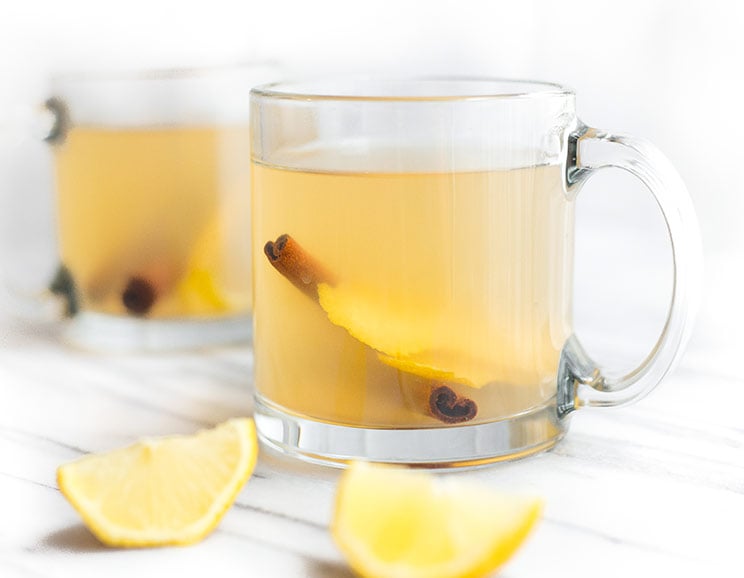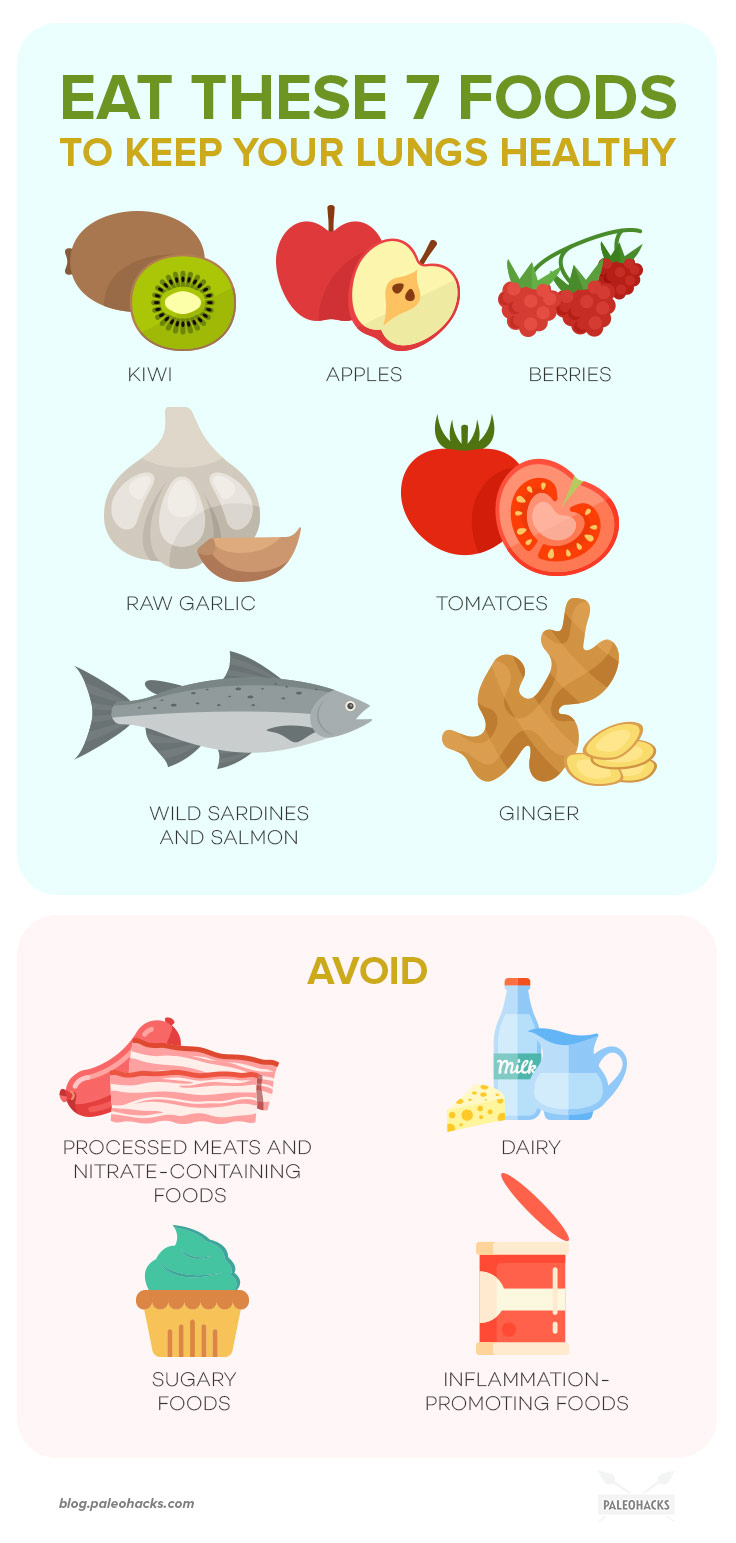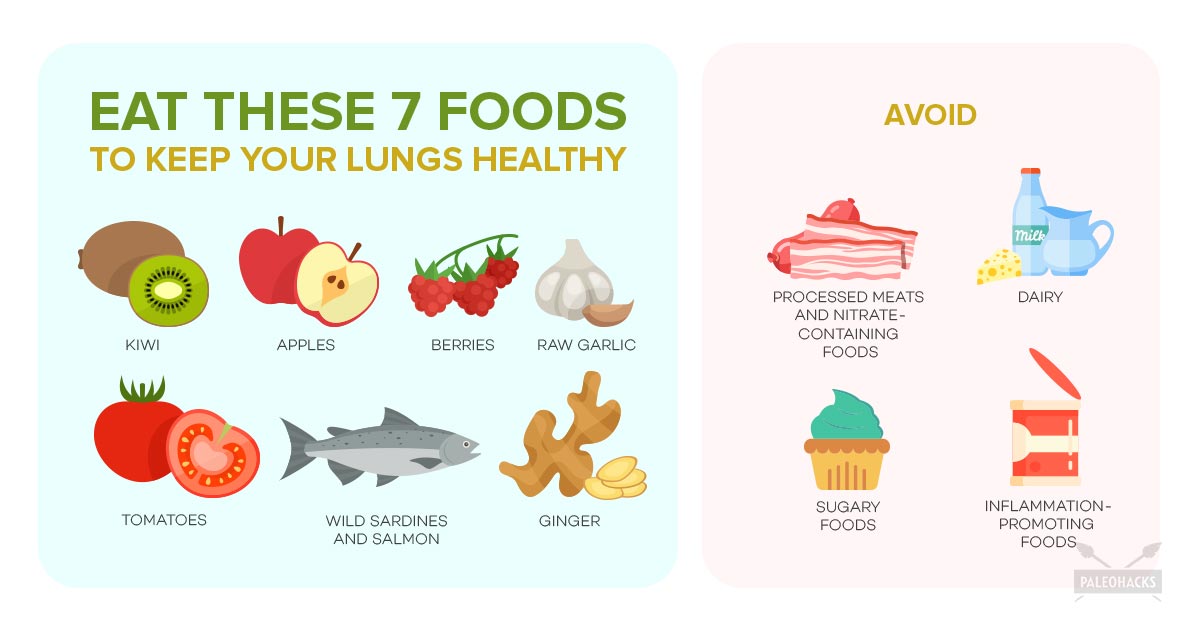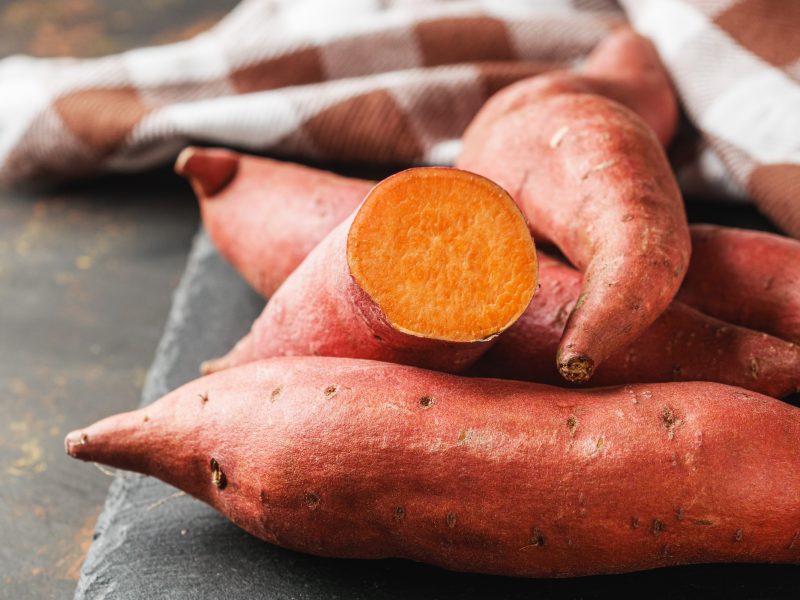How great it is to breathe and have healthy lungs. Even though they operate one of the most essential and basic operations in our bodies, our lungs typically don’t receive much attention until we find it difficult to, well, breathe.
Luckily, like our other organs, our lungs can be nourished through specific foods and herbs. They can also be strengthened to help prevent respiratory illnesses, infections, and reduced lung function due to age.
Here we’re diving into how you can support healthy lungs for the long term, and also how you can use foods to help with respiratory issues.
In need of a sugar detox?
Click here to get your FREE Sugar Detox Guide + Sugar-Free Recipes!
How Your Lungs Work
Before we dive into foods that support lung health, it helps to know the basics of how they operate.
Your lungs are part of your body’s respiratory system. They work to move fresh air into your bloodstream while expelling gaseous wastes and carbon dioxide. Made of spongy tissue and divided into sections called lobes (three in your right lung and two in your left), this system involves a highly complex series of events that are responsible for providing you with roughly 17,000 breaths per day.
When you inhale, air flows down your windpipe and flows down two tubes called bronchi – one going to each lung. These bronchi begin to branch out, becoming smaller and smaller until they eventually end at millions of tiny, elastic, balloon-like sacs called alveoli.
In these clusters of alveoli (and in just under a second!) oxygen passes from the air in your lungs into your blood, while carbon dioxide passes from your blood into your lungs.
How To Keep Your Lungs Healthy And Improve Breathing
It can be easy to overlook how vulnerable our lungs truly are since they reside inside our bodies like other organs. However, unlike our other organs, they receive direct airflow that can carry everything from our environment – including dust, viruses, bacteria, chemicals, and other scary substances – straight to our bloodstream, making them pretty vulnerable indeed.
Because of this, our airways are equipped with mucus-secreting cells, immune cells, and cells with tiny hairs called cilia that help trap threatening compounds before they can reach deep into our lungs. In addition, mucus membranes in our lungs may also become inflamed when they come into contact with threatening substances as a defense mechanism.
Even with this built-in protection system, substances and viruses can still make their way into our lungs, causing breathing trouble, coughing, inflammation, and possibly even long-term damage.
Luckily, however, in the same way, we can improve the health of other organs with food, herbs, and other therapies, we can also choose foods and different methods that help strengthen our lungs and possibly improve breathing.
Breathing exercises
Your lungs are surrounded by muscles. One of the most important that plays a huge role in breathing is your diaphragm. This muscle is shaped like a dome and found just below your rib cage. It shoulders most of the work when you inhale, contracting so that your lungs can expand into the extra space and let in the necessary amount of air.
Like other muscles, your diaphragm can be “exercised” to improve your breathing.
For example, in conditions like COPD and asthma, which are characterized by tight airways, the lungs lose elasticity and have trouble exhaling fully. This leaves air trapped in the lungs, which leaves less space for the lungs to expand into during an inhale, and therefore resulting in less oxygen intake.
Strengthening your diaphragm by doing breathing exercises can help push excess air out while increasing oxygen flow and lung elasticity. (1)
One of the best breathing exercises you can do is belly breathing or diaphragmatic breathing. To practice:
- Start by lying on the floor with your legs bent, feet flat on the floor.
- Place a book or similar-weight object on your belly, then rest your arms on the floor next to you, palms facing up.
- Close your eyes and inhale through your nose. As you inhale, push the book (i.e. your belly) up toward the ceiling. Inhale for 2 seconds.
- Hold your breath for 1 second.
- Then, exhale through your mouth with pursed lips (i.e., like you’re blowing out birthday candles) for 3 seconds, and feel your belly fall down toward your spine.
- Continue this process for 5 minutes.
Steam therapy

Steam therapy, or steam inhalation, is a method that can help loosen mucus in your airways and lungs so that you can expel it. Viruses and bacteria get caught in the mucus membranes in our lungs, which can lead to inflammation, and – if this continues long enough – pneumonia. Mucous membrane inflammation and mucus build-up is a feature of many respiratory diseases, so loosening and moving inflammatory mucus may help improve symptoms. (2, 3)
To steam:
- Heat 1 cup of water in a small pot until boiling.
- Once boiling, remove from heat, wait 1 minute, then move your head over the bowl, draping a towel over your head.
- Shut your eyes and slowly lower your head toward the hot water until you’re roughly 12 inches away from the water.
- Inhale slowly and deeply through your nose for at least 5 minutes.
Exercise
General exercise, like breathing exercises, can help increase the strength of the muscles surrounding your lungs, while also increasing your oxygen levels. It can also cause your muscles to produce less carbon dioxide over time, making breathing more efficient. (4) Try these 11 Gentle Yoga Moves to Ease Asthma.
Use natural perfumes and household products
Research shows that people exposed to chemical cleaning products like household cleaners show greater declines in lung function, and that common household cleaners can also cause lung damage. (5)
Not to mention, constant exposure to cleaning products is linked to higher asthma rates. Also, studies have found that exposure to chemicals from household cleaning products during the first 3 months of life can increase children’s risk of developing asthma. (6, 7)
Swapping out your regular countertop cleaners, air fresheners, bathroom cleaners, dish soaps, body care products, and perfumes for natural versions can go a long way in preventing lung damage and possibly improving breathing.
Drink water
Staying hydrated is essential to help keep fluids moving freely throughout your entire body, including your lungs, and can also help keep lungs moist to encourage mucus thinning and drainage.
Aim to hit the standard 8 glasses a day. Try these 21 Infused Water Recipes to Help You Hydrate.
Best Foods for Lungs

Like other organs, your lungs can be strengthened or weakened depending upon the foods you consume. You’ll notice that many of the foods recommended below contain natural anti-inflammatory and congestion-relieving compounds, which as we saw earlier can provide immense help in supporting lung health.
1. Kiwi
Research shows that vitamin C and other antioxidant compounds found in fruits can play a huge role in lung health. Time to reach for the oranges and grapefruits, right?
Well, by branching out a bit (pun intended) in the fruit aisle, you may find a better option. While citrus is a great source of vitamin C and antioxidants, kiwi fruits actually have 3 times the amount of vitamin C and other important antioxidants than oranges and strawberries.
Studies also mention that elderly participants eating several kiwi fruits per day were able to reduce the severity and duration of upper respiratory infection symptoms – featuring a direct link between the nutrients found in kiwi and improvement in a lung condition. (8)
Add kiwi to this Kale + Apple Cancer-Fighting Smoothie or try this Pineapple Fruit Salsa with Strawberries, Blueberries & Kiwis.
2. Apples
The “apple a day” saying seems to prove itself time and time again. Researchers have found that a diet high in fruits (especially apples) slows decline in lung function in former smokers.
“This study shows that diet might help repair lung damage in people who have stopped smoking. It also suggests that a diet rich in fruits can slow down the lung’s natural aging process even if you have never smoked”, says Vanessa Garcia-Larsen, assistant professor in the Bloomberg School’s Department of International Health and the study’s lead author. (9, 10)
You might like: Keep the Doctor Away with These 41 Amazing Apple Recipes.
3. Berries
Oxidative stress occurs in our body when the number of free radicals – unstable molecules that damage DNA – overwhelm the number of antioxidants in our system. These free radicals can be generated from toxins and disease, unhealthy foods, environmental pollution and chemicals, and even stress.
Researchers have found links between acute and chronic lung diseases and increased oxidative stress. The consumption of antioxidants like those found in berries may help reduce lung function decline. (11, 12)
This is because antioxidant compounds found in foods like berries help fight free radicals before they can cause damage. They can also help reduce the inflammation caused by excess free radicals. (13)
Make this Antioxidant-Rich Berry Tart Recipe for an afternoon treat.
4. Raw Garlic
Garlic contains potent anti-inflammatory and anti-microbial compounds that may help improve respiratory infections. One animal study showed that supplementing with garlic helped remove tracheal mucus, which could help clear the lungs of inflammatory microbes. (14)
Another study found that raw garlic supplementation was associated with a reduced risk of lung cancer. (15)
If you struggle to eat raw garlic, try this Simple Dairy-Free Pesto.
5. Tomatoes
Tomatoes are another food that contains high levels of antioxidants that could help support lung health. Studies have found that people who have high serum levels of carotenoids, a class of antioxidant compounds found in tomatoes, enjoy better lung health on average. (16)
Another found that former smokers with the highest amount of tomato consumption experienced less lung function decline as they age. (17)
Try this Cool-as-a-Cucumber Caprese Salad or make this Easy, Refine Sugar-Free Marinara Sauce.
6. Wild Sardines and Salmon
Wild fatty fish like sardines and salmon are rich in vitamin D. Researchers have found that vitamin D deficiency is linked to all types of chronic lung diseases. These include interstitial pneumonia, cystic fibrosis, asthma, and chronic obstructive lung disease. (18)
Vitamin D has potent anti-inflammatory properties, and also plays a huge role in your immune system function, which researchers believe are some of the many reasons vitamin D can help prevent or improve respiratory issues.
You might like to try: Fisherman’s Eggs Recipe (Protein-Rich + Healthy Fats).
7. Ginger
If you’re experiencing lung issues or dealing with a respiratory infection, you may want to up your dosage of ginger tea. Animal studies show that ginger efficiently reduces lung damage and can protect the lungs from severe damage due to hyperoxia and inflammation. (19)
Ginger is also extremely high in antioxidants, with studies showing it is surpassed by only pomegranates and some types of berries. (20)
Recipes to try: Easy Peasy Ginger Date Bars and Carrot Ginger Soup with Anti-Inflammatory Turmeric.
As an aside, it’s interesting to note that research has also found higher intakes of fiber is correlated with better overall lung health. (21) You’ll notice most of these foods are naturally high in fiber, providing a one-two punch for healthy lungs.
Foods to Avoid

In general, the foods you want to avoid to support lung health are those that cause inflammation, can blunt your immune system, and processed foods that contain additives, like nitrates.
Processed meats and nitrate-containing foods
Studies show that added nitrates, a preservative found in processed meats, increased the risk for COPD hospital readmissions. (22)
Avoid: Cold cuts, bacon, beef jerky, and other processed meats unless organic and the package specifically states “nitrate-free”.
Dairy
Some studies suggest proteins in milk and dairy can cause increased mucus production. (23) And, while studies are conflicted, many asthma sufferers claim that dropping dairy from their diet drastically reduced symptoms.
Avoid: Processed dairy products including milk, cheese, cream, etc.
Sugary foods
Studies show that sugar can directly suppress your immune system by impairing the function of phagocytes, immune cells that help fight disease and invaders like viruses, after just one meal. (24)
Avoid: Processed flours and other carbohydrate foods like granola bars, muffins, cupcakes, cookies, etc. Avoid candies and chocolate containing added sugars and corn syrups.
Note that natural sugars from whole fruits and starches like sweet potatoes are fine.
Inflammation-promoting foods
Fried foods and other processed foods often contain pro-inflammatory oils that have shown in studies to increase widespread inflammation. (25) As we saw earlier, inflammation can play a key role in worsening respiratory issues.
Avoid: Fried foods, boxed, or canned processed foods.
Bottom Line
Like other organs, our lungs can respond to certain beneficial nutrients and compounds in a positive way, and certain breathing practices can also increase their function. In addition, lung conditions can be made worse by consuming inflammation-promoting unhealthy foods.
Following a healthy diet high in antioxidants and following some of the practices that support lung health can go a long way in supporting and preventing lung and breathing issues.
Read This Next: Breathe Easy DIY Eucalyptus Vapor Rub



